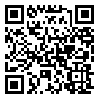Volume 2, Issue 1 (1-2020)
sjis 2020, 2(1): 1-6 |
Back to browse issues page
Download citation:
BibTeX | RIS | EndNote | Medlars | ProCite | Reference Manager | RefWorks
Send citation to:



BibTeX | RIS | EndNote | Medlars | ProCite | Reference Manager | RefWorks
Send citation to:
Mirghafoori S H, Sayyadi Toranlu H, Dehghani Ashkezari J. Provision of a Model to Spread the Use of Information Technology in Serving. sjis 2020; 2 (1) :1-6
URL: http://sjis.srpub.org/article-5-55-en.html
URL: http://sjis.srpub.org/article-5-55-en.html
Associate Professor of Yazd Science and Art University
Abstract: (2731 Views)
After the arrival of new technologies to communities, the way of using these technologies in organizations had been encountered with several developments. An organization's authorities necessarily need to understand that today accountability and acceptance responsibility in organizational serving criteria has been reached into the field of information technology. Dependency of organizations and employees and referrers, as well as organizational processes and procedures on information technology tool has doubled the necessity to take seriously the issue called information technology universality in server organizations. Therefore, information technology universality is an organizational advantage. Organizations need to be managed effectively in information technology universality for serving in order to succeed. The purpose of this article is to provide appropriate and desirable strategies for serving by spreading the use of information technology. The effective factors on spreading the use of information technology for serving have been firstly identified in this article. Then, the current and desirable status of organization in terms of the use of information technology has been investigated. In continue the appropriate strategies have been provided to apply information technology for serving in this institution while identifying critical factors.
Type of Study: Research |
Subject:
Computer Networks and Communications
Received: 2019/10/14 | Revised: 2019/12/22 | Accepted: 2019/12/25 | Published: 2020/01/31
Received: 2019/10/14 | Revised: 2019/12/22 | Accepted: 2019/12/25 | Published: 2020/01/31
References
1. Anvari-H. et al., Statute of the Imam Khomeini Relief Committee (RA),2015
2. Asadi-a, Karimi-A.2007. Analysis of factors affecting the IT applications by the teachers training centers Applied Science, Journal of Agricultural Sciences Iran, 2-38 (2), 277-289.
3. Durrani-k. And (g). Rashidi. 2013. Factors affecting adoption of information technology by smart school teachers in Tehran, with an emphasis on information technology acceptance model, research in educational systems, 1 (1), 23-46.
4. Edwards-M.C., B., McLucas-G.E., Briers, and F. Rohs. 2011. Educational interests of secondary agricultural education teachers in Georgia: Implications for the delivery of educational programming at a distance, journal of agricultural education, 45 (3), 75-85. [DOI:10.5032/jae.2004.03075]
5. Falaki-d., E. SH fami, e. Iravanian & H. Mohammadi-M. 2009. Analysis of factors affecting users of information technology experts agricultural extension Iran, Iranian Journal of Agricultural Science, 3-38 (2), 185-197.
6. Hsu-M.K., S.W., Wang, and K.K. Chiu. 2009. Computer attitude, statistics anxiety and self-efficacy on statistical software adoption behavior: An empirical study of online MBA learners, computers in human behavior, 25 (2), 412-420. [DOI:10.1016/j.chb.2008.10.003]
7. Karimi-a., M. Mokhtarnya and L-Safa. 2015. Analysis of Factors Affecting the Use of information and communication technologies in vocational training agricultural (A Case Study of Zanjan province), Journal of Agricultural Sciences Iran, 3-38 (1), 149-160.
8. Khvilon-E. 2012. Information and communication technology in education: A curriculum for schools and programme of teacher education, United Nations Educational, Scientific and Cultural Organization (UNESCO).
9. Lorin-M.H. & B., Erick. 2010. Information technology and internal firm organization: An exploratory analysis, journal of management information systems, 14 (9), 81-84.
10. Maningas-R. V. & S. T. Mancebo. 2011. Utilization of IT-based services and communication technology media by end-users of agricultural research and extension networks in the Philipins, AFITA / WCCA joint congress on IT in agriculture, 13-20, Thailand: Bangkok.
11. Mashhadi-m., Of. Rezvanfar and c. Yaghubi. 2011. Factors affecting the use of information technology by faculty members of Tehran University of Agriculture and Natural Resources, Journal of Research and Planning in Higher Education, 44 (2), 151-171.
12. Pouratashi-M., & M., Mokhtarnia. 2009. Investigating factors influencing use of internet by agricultural faculty members for educational and research activities, American-Eurasian J. agric. & Environ. Sci., 5 (3), 398-402.
13. Rezaei-M., H., Movahed Mohammadi-A., Asadi, & Kh., Kalantary. 2013. Predicting e-learning application in agricultural higher education using technology acceptance model, Turkish Online Journal of Distance Education, 9 (1), 85-95.
14. Saade-R.G., and D., Kira. 2013. The emotional state of technology acceptance, issues in informing science and information technology, 3, 529-539. [DOI:10.28945/913]
15. Sheykhshojay-p. And i. Olumi. 2012. Factors affecting adoption of information technology by technical faculties of universities in Tehran librarians, Library and Information Science, 10 (3), 9-34.
16. Sun-H., and P., Zhang. 2014. The role of moderating factors in user technology acceptance, Int. J. human-computer studies, 64, 53-78. [DOI:10.1016/j.ijhcs.2005.04.013]
17. The institute for higher education policy. 2013. Quality on the line: benchmarks for success in internet-based distance education, national education association, Washington, DC.
18. Tung-F.C., & S.C., Chang. 2008. Nursing students' behavioral intention to use online courses: A questionnaire survey, international journal of nursing studies, 45, 1299-1309. [DOI:10.1016/j.ijnurstu.2007.09.011] [PMID]
19. Yaghoubi-J., & E., Shamsai. 2013. Assessing effective factors in using internet by faculty members of agricultural college of Zanjan University; Iran, Proceedings of the 19th Annual Conference Dublin, Irland, May 23-29, 604- 608, http://www.aiaee.org/ 2004 / accepted / 088.pdf (accessed December 2009).
20. Yi, M.Y., & Y., Hwang. 2003. Predicting the use of web-based information systems: self-efficacy, enjoyment, learning goal orientation, and the technology acceptance model, international journal of human-computer studies, 59, 431-449. [DOI:10.1016/S1071-5819(03)00114-9]
21. Yi, M.Y., J.D., Jackson-J.S., Park, & J.C., Probst. 2006. Understanding information technology acceptance by individual professionals: Toward an integrative view, information & management, 43, 350-363. [DOI:10.1016/j.im.2005.08.006]
22. Yu, P., H., Li, & M.P., Gagnon. 2008. Health IT acceptance factors in long-term care facilities: A cross-sectional survey, international journal of medical informatics, 78 (4), 219-229. [DOI:10.1016/j.ijmedinf.2008.07.006] [PMID]
Send email to the article author
| Rights and permissions | |
 |
This work is licensed under a Creative Commons Attribution-NonCommercial 4.0 International License. |









